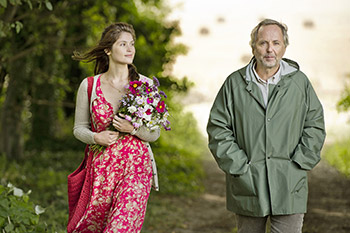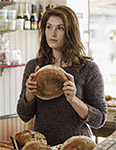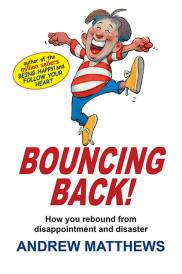Anne Fontaine - Gemma Bovery

Gemma Bovery
In this vibrant seriocomic re-imagining of Flaubert's literary classic Madame Bovary, life imitates art in uncanny ways when earthy British beauty Gemma Bovery (Gemma Arterton) and her furniture restorer husband Charles (Jason Flemyng) move to a charming ramshackle old farmhouse in the very same Norman village where the novel was written a century earlier. Their welcoming neighbor, local baker and Flaubert expert Martin Joubert (Fabrice Luchini) becomes entranced with Gemma and sets out to be her guide and mentor to her new surroundings. It doesn't take long before he is drawing parallels between the literary and real life woman, while he insinuates himself into her life.
As reality sets in on the fantasy of rural French domesticity, the Boverys' marriage begins to fray and Gemma finds herself at loose ends. She soon catches the eye of a handsome young playboy and when her magnetic ex suddenly reappears, she finds herself at a crossroads and seems to be fulfilling Joubert's worst fears that her destiny is linked to that of Flaubert's doomed heroine. Director Anne Fontaine's (COCO BEFORE CHANEL) clever adaptation of Posy Simmonds' graphic novel Gemma Bovery is at once a cheeky literary mash-up, a sensuous romance, a witty feminist commentary and a heady celebration of French provincial life.
Gemma Bovery in cinemas 28th May.
INTERVIEW WITH ANNE FONTAINE
How did you discover Posy Simmonds's graphic novel Gemma Bovery?
I knew Posy Simmonds through (her graphic novel) Tamara Drewe and immediately felt a connection to her Gemma Bovery: the word play on this twisted, female literary archetype seemed promising and fun. When I read the novel, the characters intrigued and touched me; I felt their comedic potential and human depth and was seduced by the author's tone, which was somewhere between dark comedy and great irony. I was also aware of the improbability of the meeting between a baker and this modern young Englishwoman who ends up lightening his life, while he had been convinced he had his libido under control and believed himself to effectively be in sexual retirement! Here he is, getting all worked up about the link between a fictional character – Emma Bovary – and the real Gemma Bovery. This fetish side seemed extremely attractive for a future scene in the film. I tried to stay faithful to the novel, while still taking liberties. In the novel, Martin, the narrator, is rather indirectly involved in the story, whereas in the film he is given a bigger presence and greater freedom.
You co-wrote the script with Pascal Bonitzer and Posy Simmonds.
What struck me in Posy Simmonds's style of writing is the need to keep a keen sense of comedy, because there's a side of 'French Woody Allen" in this depressed baker whose imagination and uniqueness come from a funny place. Meeting Pascal, I told myself that his sense of humor was mixed with despair, and when he is in character, for me, these two identities cannot be separated. The character of Martin is living vicariously through a love that's forming for a girl with incredible sensuality – who doesn't look at him as a desirable man, but as a neighbor and local baker. I thought that the tone and the spirit were essential to express the humor of this discrepancy. As soon as we started writing, Pascal and I had quickly developed a common empathy for the subject, and then Posy
joined the team for the English dialogue. It was an invaluable collaboration because sometimes we 'betrayed" her writing, and when we spoke to her about it she had the flexibility to welcome our suggestions. It was interesting therefore to have her reactions to situations that we had invented and which were certainly inspired by the original story, but which didn't necessarily stick to the comics. For example, we understood that for the film, the narration had to be more immediate and more direct than the graphic novel, which is, by nature, more literary.
How did the characters develop?
We were hoping that the baker's story would be in the foreground, and the whole plot would unfold through his eyes – unlike the book, which is told from multiple points of view and could have caused confusion in the film. Gemma Bovery remains fairly true to the original character as a cross between a contemporary Madame Bovary and a modern-day fickle English girl who doesn't know how to express her feelings nor realize the effect she has on men, even just by looking at them. In the novel, she sometimes comes across as unfriendly, which we changed to make her sweet and generous. Of course she manipulates men, but almost unconsciously, making her less calculating and more like Madame Bovary, who expects something from love. In the book, Charlie is almost a neutral character, without any charisma, but I wanted to make him more charming. As for Patrick, from the compulsive seducer that he is in the novel, we chose to make him a stranger, murkier, more poisonous character, allowing for a more ambiguous outcome to the story.
The baker is taken for a deus ex machina, who enjoys pulling the strings…
Yes, because he is a storyteller, halfway between a director and a writer, who works with real life. At the market, in front of his bakery, he confides in the audience that he's like a 'a director who has just called action!" He sees the young chateau owner, that he had himself introduced to Gemma, coming to meet him; then he imagines their
conversation aloud, and his 'creatures" repeat his own lines, as if he were the author of their lives. Of course, this troubles him. Deep down he knows he is too involved in their intimacy and his imaginings.
Which doesn't prevent him from suffering, on the contrary even.
Watching the house across the street through the window, or at the market, he analyzes the relationship between the local chateau owner and Gemma. He realizes that his introduction has created a relationship that brings him suffering. Although he has clearly experienced his own great love in the past, it is also clear that his life has become mundane since he took over the bakery. Gemma's arrival shakes things up for him. It's quite immediate and gradually he fetishizes their relationship, due to this young woman's powerfully evocative name. His passion is twofold: she represents a parallel world of what could be and displaces him by being so irresistible. When he says that ten years of sexual peace have been eliminated at once by a mere "insignificant gesture," he reveals his hypersensitivity. And as happens so often, unrequited love hurts and is difficult to face up to.
However much a 'director" Martin is, he cannot avoid the unavoidable…
There's a permanent irony in the way Gemma is, unwittingly, following in the footsteps of Emma Bovary… it says a lot about fate and the cruelty of it. And despite everything, the reality of the situation escapes the all-knowing Martin, which makes him all the more human. When he states that 'life imitates art" he has no other choice than to let things happen without having control over them. The links between fantasy, fate and reality fascinate me and create a surprise effect that distances this film from a classic romantic comedy.
You could be led to believe that the character of Martin has been custom-made for Fabrice Luchini…
And yet an English woman invented him! But when I read the graphic novel, I immediately imagined him as Fabrice Luchini, not just as an actor but as a being that has Flaubert in his blood, deep within him. Given that I knew him well, and that I have so often talked to him about Madame Bovary as a real person, I had the feeling that this role had been waiting for only him. I therefore wrote the script, telling myself that there was a quite strong possibility that he would like the character, and that he would be touched by, like me, this literary obsessive, leading a peaceful life as a baker until this fantasy meeting transforms his own reality. It was great to have an actor like Fabrice Luchini, as he has the understanding of the fantasy and of the gap, but also pleasure and love of words, which corresponds to the same subject of the film. I was so lucky to have such an actor, as only Fabrice could pass off this obsession for Madame Bovary as something utterly natural. The process of living in the body of this man – and his madness as well – materializes as soon as he utters the words, in his unique way, 'Gemma Bovery." It was especially more important that it be about a character that observes other peoples' lives through a window and that places him in the position of a voyeur who invents stories. As I found that the character was close to a director, there was a very strong hidden link between us.
Which is rarely seen in cinema, in this light.
I wanted to make him beautiful; I was keen to show off his piercing green eyes - as if he's playing a character that seems to have a rather vague sexual life, I found it interesting to give him some physical charm. The fact that he's more mature now really suits him: there's intensity and a seriousness that has been etched on his face.
How do you direct him?
I always experiment with him, always in a playful way. We look for different tones, we go too much in one direction, we try again and again, and then we backtrack to where we started. You have to find the exact tone by asking how far can we take it? I never block him in by placing him in a constricting frame; we film nine or ten takes and then I tell him 'now, forget what I told you, do whatever you want". But what counts above all is the
absolute confidence that we share.
Did you think of Gemma Arterton after watching Tamara Drewe?
I had seen Gemma in Tamara Drewe, and in a way I had told myself that because she had already played a character written by Posy Simmonds, this role wouldn't interest her. So I met with some English actresses with one objective in mind; they had to be sexy when speaking French. But none of those I'd met with had aroused anything in me. Eventually I met Gemma Arterton, and as soon as she opened the door and read me a little extract in French that she had written, I knew that I was dealing with an atomic bomb; she gives off an energy that means you cannot help but love her. She has a warm and generous beauty, and doesn't distance herself from you, so much so that her doubts and hesitancies are attributable to her youth and her coolness and not her
acting. I didn't even need her to do a test; she came to France and spent three months really immersed in the local culture before working on the character. To avoid her coming across as too rigid when speaking French – which can be a risk when actors have to learn a foreign language – I asked her to move constantly and to be in the action. To finish, she turned up extremely prepared on set, telling me that the character was close to her.
And for the other roles?
For the couple of Fabrice and Gemma, I chose actors who would gravitate around them. The secondary characters introduce the idea of these English people who consider France as a green haven, and the French peoples' often-suspicious impression of the English. Even if it's not the overriding theme of the film, this enriches the primary difference. I was very happy to trust Elsa Zylberstein in the role of a woman with strange phobias and unusual notions about taste and food. We wrote much of her dialogue together, and I was surprised by her ability to be funny without being ridiculous. She does really well personifying Posy Simmonds' spirit, whose characters are sometimes at the limit of outrageousness, while still remaining endearing.
Isabelle Candelier, who I had loved in Bruno Podalydes' films, has a thankless role in appearance, but very funny and effective; she plays someone who is a bit stiff, her feet firmly on the ground, both exasperated and indulgent, faced with a husband locked in his own interior world, and they complement each other. The family is completed by Kacey Mottet-Klein, who was great in Gainsbourg and Ursula Meier's films Home and Sister, and whose uniqueness is surprising. For Hervé, the young lord from a weak family embodying a kind of sex toy, I chose Niels Schneider after discovering him in the films of Xavier Dolan, where I noticed that he had the face of a cherub; between the statue that is broken and himself, there is a kind of connivance in his fragility. Edith Scob, who plays his mother, and whom I have always loved, gives a strange, comic dimension to the film, almost supernatural. And Pascale Arbillot made friends with us just to come give the final wink. For the English characters, I had picked out Mel Raido, who plays Patrick, from a British television series: I loved his strange, poisonous side, which creates a certain tension. And I chose Jason Flemyng, who I had seen in many films, because he personifies kindness and generosity and seems like a good man. It was especially more emotional as he's a man who is wronged by everyone. I didn't, however, know Pip Torrens, whose conservative middle-class characterization put a smile on Fabrice Luchini's face throughout filming.
The film exudes an extraordinary sensuality.
I thought that eroticism should be found in the scenery and sounds of Normandy, but also in Martin's profession: as he says himself, to knead dough brings about a great calm in him – it's his 'yoga". When he teaches Gemma how to use the kneading machine, when she's pressed up against him, there is a very strong form of eroticism that emanates from his breath, his movements. I really loved the idea of this artisan baker contrasted with his extreme creativity. Bread has allowed Martin to reconcile with something from nature after having had a brilliant, intellectual career. As the two characters do not have a direct sexual relationship, we have to perceive the sensuality elsewhere.
The lighting is warm and comforting. How did you work with the director of photography, Christophe Beaucarne?
This is the third film that I've made with him, alongside Coco before Chanel and Perfect Mothers. So it's a very important collaboration for me. We had talked of having this warm and enveloping light, without it being too boring and formal. We wanted natural, enhancing lighting so it's truthful, but that it's reinterpreted, in relation to the emotion of each scene. So we chose to film at the time of year when the Normandy countryside is at its most beautiful. It was especially important to give a sunny side to the film since the subject matter is quite dark.
You film with a large frame size…
We filmed in Scope, but the camera is often projected, which gives an impression of fluidity and sensuality, without needing any big camera movements. In reality, I thought of the film through Luchini's eyes; even when he's not in frame, we still have the feeling that there's someone permanently in the background. And that's what produces, I think, a certain mystery and a certain tension. Besides, I wanted the camera to shift smoothly between Martin's dreamlike visions - such as the hallucination in the cathedral or the ballroom scene in another time – and reality. So it means that we're are always in his head.
This is the second time that you've worked with Bruno Coulais, after My Worst Nightmare.
I thought it would be interesting to alternate an English melody, just for Gemma, and another piece of music for the film itself. Bruno and I were looking for a pure, graceful, feminine voice and it was the female singer of the band Moriarty who seduced us. Bruno composed the music in advance to find a particular tone, both lively and tongue in cheek, without being psychoanalytical or romantic. What I liked is that it's a score that forges ahead, but isn't representative nor over the top in relation to the action. It's a real pleasure to work with Bruno, who knows how to be flexible without renouncing his own universe.
Have You Seen This?
MORE
- Mission: Impossible Fallout
- Glenn Close The Wife
- Allison Chhorn Stanley's Mouth Interview
- Benicio Del Toro Sicario: Day of the Soldado
- Dame Judi Dench Tea With The Dames
- Sandra Bullock Ocean's 8
- Chris Pratt Jurassic World: Fallen Kingdom
- Claudia Sangiorgi Dalimore and Michelle Grace...
- Rachel McAdams Disobedience Interview
- Sebastián Lelio and Alessandro Nivola...
- Perri Cummings Trench Interview






